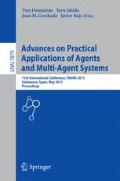Abstract
This work presents an approach combining multiple electronic patient records (EPR) to a self-learning fall risk assessment tool. We utilized the agent-perspective to model the system, to address privacy issues and to evaluate different distributed information fusion and opinion aggregation techniques towards there applicability to the addressed domain. Each agent represents a single patient negotiating about unknown fall risk influences in order to adapt the fall-risk assessment tool to the population under care. In addition, we will outline the planned real-world case study.
Access this chapter
Tax calculation will be finalised at checkout
Purchases are for personal use only
Preview
Unable to display preview. Download preview PDF.
References
Ahrndt, S., Rieger, A., Albayrak, S.: Entwicklung einer mobilen elektronischen Patientenakte für die ambulante Versorgung in ländlichen Regionen (development of a mobile electronic patient record for ambulatory health care in the countryside). In: Goltz, U., Magnor, M., Appelrath, H.J., Matthies, H., Balke, W.T., Wolf, L. (eds.) INFORMATIK 2012. Lecture Notes in Informatics, vol. (208), pp. 1167–1181. Gesellschaft für Informatik, Braunschweig (2012)
Bernardo, J.M., Smith, A.F.M.: Bayesian theory. Wiley series in probability and statistics, Wiley, Chichester [u.a.], repr. edn.(2004), http://www.ulb.tu-darmstadt.de/tocs/133503178.pdf
Cooke, R.: Experts in Uncertainty: Opinion and Subjective Probability in Science. Oxford University Press (January 1991)
Fähndrich, J.: Analyse von Verfahren zur Kombination von Expertenwissen in Form von Wahrscheinlichkeitsverteilungen im Hinblick auf die verteilte lokale Bayes’sche Fusion. Diploma thesis, Karlsruhe Institut of Technology (May 2010)
Fiss, T., Dreier, A., Meinke, C., van den Berg, N., Ritter, C.A., Hoffmann, W.: Frequency of inappropriate drugs in primary care: Analysis of a sample of immobile patients who received periodic home visits. Age and Ageing 40(1), 66–73 (2010)
Fiss, T., Ritter, C.A., Alte, D., van den Berg, N., Hoffmann, W.: Detection of drug related problems in an interdisciplinary health care model for rural areas in germany. Pham. World Sci. 32(5), 566–574 (2010)
Genest, C.: Pooling operators with the marginalization property. The Canadian Journal of Statistics/La Revue Canadienne de Statistique 12(2), 153–163 (1984), http://www.jstor.org/stable/3315179
Genest, C., McConway, K.K., Schervish, M.M.: Characterization of externally bayesian pooling operators. The Annals of Statistics 14(2), 487–501 (1986), http://www.jstor.org/stable/2241231
Genest, C., Weerahandi, S., Zidek, J.: Aggregating opinions through logarithmic pooling. Theory and Decision 17, 61–70 (1984), http://www.springerlink.com/index/XT152131QJ43G001.pdf
Goth, G.: Analyzing medical data. Communications of the ACM 55(6), 13–15 (2012)
Halpern, J.: From statistical knowledge bases to degrees of belief: an overview. In: Proceedings of the Twenty-Fifth ACM SIGMOD-SIGACT-SIGART Symposium on Principles of Database Systems, p. 113. ACM (2006), http://portal.acm.org/citation.cfm?id=1142367
Hirsch, B., Konnerth, T., Heßler, A.: Merging agents and services – the JIAC agent platform. In: Bordini, R.H., Dastani, M., Dix, J., Amal, E.F.S. (eds.) Multi-Agent Programming: Languages, Tools and Applications, pp. 159–185. Springer (2009)
Hoffmann, W., van den Berg, N., Thyrian, J.R., Fiss, T.: Frequency and determinants of potential drug-drug interactions in an elderly population receiving regular home visits by GPs – results of the home medication review in the AGnES-studies. Pharmacoepidemiology and Drug Safety 20(12), 1311–1318 (2011)
König, H.H.: Gesundheitsökonomische Aspekte der Sturz- und Frakturprävention (2012), http://www.sturzpraevention2012.de/programm_abstract.php?No=9 (last visit: October 29, 2012)
Lindley, D.: Theory and practice of bayesian statistics. The Statistician 32(1), 1–11 (1983), http://www.jstor.org/stable/2987587
Mohomed, I., Misra, A., Ebling, M., Jerome, W.: HARMONI: Context-aware filtering of sensor data for continuous remote health monitoring. In: Sixth Annual IEEE International Conference on Pervasive Computing and Communications (PerCom 2008), pp. 248–251. IEEE Computer Society (March 2008)
Moulton, B., Chaczko, Z., Karatovic, M.: Data fusion and aggregation methods for pre-processing ambulatory monitoring and remote sensor data for upload to personal electronic health records. International Journal of Digital Content Technology and its Applications 3(4), 120–127 (2009)
Pennock, D., Wellman, M.: Graphical models for groups: Belief aggregation and risk sharing. Decision Analysis 2(3), 148–164 (2005), http://ai.eecs.umich.edu/people/wellman/pubs/decisionanalysis05.pdf
Roback, P.J., Givens, G.H.: Supra-bayesian pooling of priors linked by a deterministic simulation model. Communications in Statistics – Simulation and Computation 30, 447–476 (2007)
Rubenstein, L.Z., Josephson, K.: Falls and their prevention in elderly people: What does the evidence show? Med. Clin. North Am. 90(5), 807–824 (2006)
Schenk, A., Ahrndt, S., Albayrak, S.: Predicting fall risks in electronic patient records. In: Goltz, U., Magnor, M., Appelrath, H.J., Matthies, H., Balke, W.T., Wolf, L. (eds.) INFORMATIK 2012. Lecture Notes in Informatics, vol. (208), pp. 1194–1198. Gesellschaft für Informatik, Braunschweig (2012)
Torra, V., Narukawa, Y.: Modeling decisions: information fusion and aggregation operators. Springer (2007)
Wark, E.B.J.S.: Concepts, Models, and Tools for Information Fusion. Artech House (2007), http://www.amazon.com/Concepts-Models-Tools-Information-Fusion/dp/1596930810
Author information
Authors and Affiliations
Editor information
Editors and Affiliations
Rights and permissions
Copyright information
© 2013 Springer-Verlag Berlin Heidelberg
About this paper
Cite this paper
Ahrndt, S., Fähndrich, J., Albayrak, S. (2013). Preventing Elderly from Falls: The Agent Perspective in EPRs. In: Demazeau, Y., Ishida, T., Corchado, J.M., Bajo, J. (eds) Advances on Practical Applications of Agents and Multi-Agent Systems. PAAMS 2013. Lecture Notes in Computer Science(), vol 7879. Springer, Berlin, Heidelberg. https://doi.org/10.1007/978-3-642-38073-0_1
Download citation
DOI: https://doi.org/10.1007/978-3-642-38073-0_1
Publisher Name: Springer, Berlin, Heidelberg
Print ISBN: 978-3-642-38072-3
Online ISBN: 978-3-642-38073-0
eBook Packages: Computer ScienceComputer Science (R0)

